NEUTRON STARS AND PULSARS
When stars that initially had between 8 M⊙ and 25 M⊙ explode as supernovae, their expanding cores are stopped by the outer layers into which they slam. The cores recontract and remain intact as highly compressed clumps of neutrons, called neutron stars. Isolated neutron stars, resulting from these explosions, are stable stellar remnants with masses between 1.25 M⊙ and about 3 M⊙.
12-6 The cores of many Type II supernovae become neutron stars
The neutron was discovered during laboratory experiments in 1932. Inspired by the realization that white dwarfs are supported by electron degeneracy pressure, Fritz Zwicky and Walter Baade proposed that a similar repulsion between neutrons could support remnant neutron cores. They used the fact that the Pauli exclusion principle also prevents neutrons with identical properties from packing too closely together. When neutrons are pressed together, many of them have to move rapidly (so as not to be identical to their neighbors). This motion provides a pressure, called neutron degeneracy pressure, that equations predict is even greater than electron degeneracy pressure (see Section 11-
Most scientists ignored Zwicky and Baade’s theory for years. After all, a neutron star seemed to be a rather unlikely object. To transform protons and electrons into neutrons, the density in the star would have to be equal to nuclear density, about 1017 kg/m3 (1.7 × 1017 lb/yd3), Thus, a teaspoon full of neutron star matter brought back to Earth would weigh about 1 billion tons. Put another way, neutron star matter is 200 million times denser than matter found in a white dwarf. Furthermore, an object compacted to nuclear density would be very small. A 2 M⊙ neutron star would have a diameter of only 20 km (12 mi) and would fit inside any major city on Earth. The surface gravity on one of these neutron stars would be so strong that the escape velocity would equal one-
In that year, Dame Jocelyn Bell Burnell, then just Jocelyn Bell, a graduate student in radio astronomy at Cambridge University, noticed that the radio telescope she was using was detecting regular pulses from one particular location in the sky. Careful repetition of the observations demonstrated that the radio pulses were arriving with a regular period of 1.3373011 seconds. The regularity of this pulsating radio source was so striking that the Cambridge team suspected that they might be detecting signals from an advanced alien civilization, which accounts for the name first assigned to it: LGM1 (short for Little Green Men 1). This possibility was soon discarded as several more of these pulsating radio sources, which came to be known as pulsars, were discovered across the sky. The broad distribution of pulsars would require incredibly widespread civilizations, inconsistent with what we have found in our searches for alien intelligence (see Chapter 15). In all cases, the pulsar periods were extremely regular, ranging in those early days between 0.2 and 1.5 seconds (Figure 12-
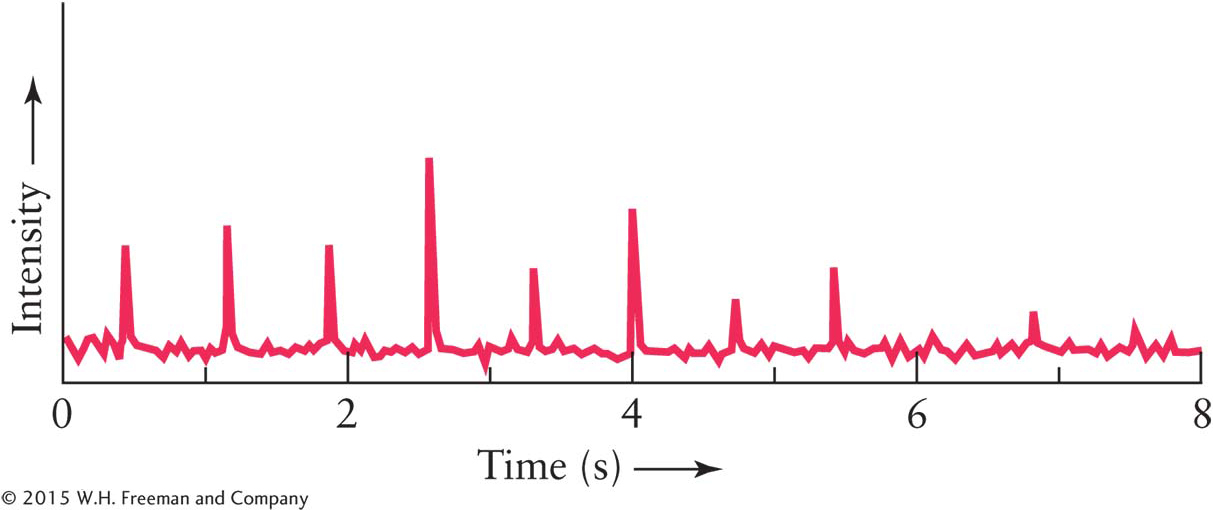
When the discovery of pulsars was officially announced in early 1968, astronomers around the world began proposing all sorts of explanations. Many of these theories were bizarre, and arguments raged for months. We have already ruled out alien civilizations. Astronomers therefore looked for some recurring event in a star’s life. We know that a star sheds matter as it swells to a giant. Perhaps some stars alternately expand and contract, emitting energy as they pulsate. However, this explanation also fails because any star expanding and contracting as fast as a pulsar emits pulses would explode.
363
Focus Question 12-8
How big is a neutron star?
Late in 1968, all controversy was laid to rest with the discovery of a pulsar in the middle of the Crab Nebula. In the year 1054, Native American, Chinese, and possibly other peoples saw and recorded the appearance of a “guest star” in the constellation of Taurus. When we turn a telescope toward this location, we find the Crab Nebula, shown in Figure 12-
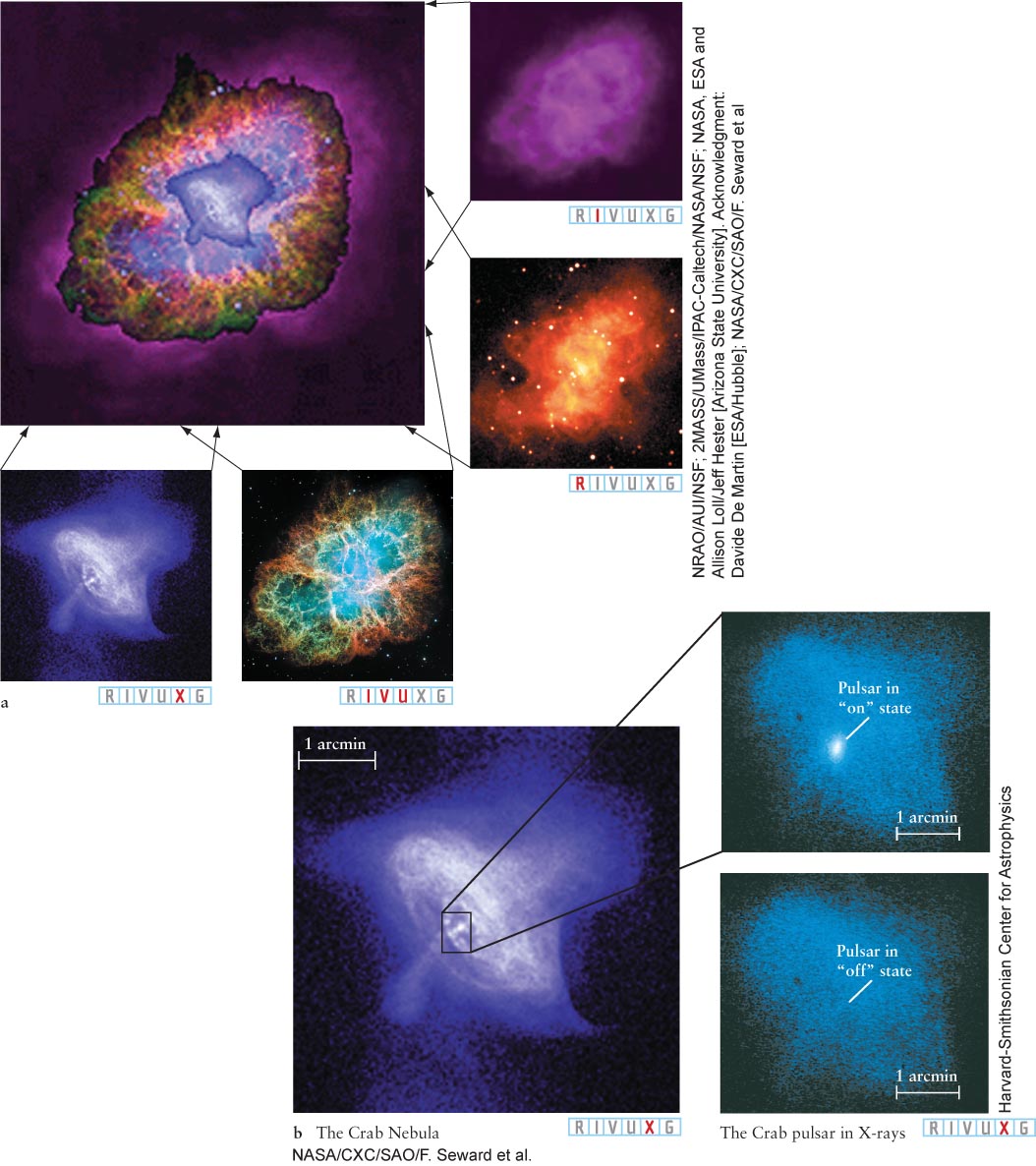





 The Crab Nebula and Pulsar (a) This nebula, named for the crablike appearance of its filamentary structure in early visible-
The Crab Nebula and Pulsar (a) This nebula, named for the crablike appearance of its filamentary structure in early visible-364
With expansion and contraction ruled out, the likely scenario is that pulsars are spinning objects. If the Crab pulsar is spinning, it is spinning too fast to be a white dwarf. Its period is 0.033 second, which means that it rotates 30 times each second. At that speed, something as wide as a white dwarf would immediately fly apart. Strengthening the case against pulsars being white dwarfs, astronomers discovered numerous other pulsars rotating even faster, including PSR 1937+21 (PSR for pulsar and 1937+21 for the object’s approximate right ascension and declination), a stellar remnant that pulses 640 times each second. Staying with the belief that pulsars are spinning, astronomers concluded that they must be incredibly compact. Calculations revealed that, if neutron stars exist, they have a sufficiently small diameter to remain intact while rotating as fast as pulsars pulsate. Indeed, this was the only explanation that withstood the process of scientific scrutiny, and, as a result, the theory of neutron stars described earlier was eventually developed.
12-7 A rotating magnetic field explains the pulses from a neutron star
Why are neutron stars rotating so fast, and how do they emit pulses of electromagnetic energy? Based on observations of the rotation of the Sun, Betelgeuse, and other stars, astronomers theorize that many, perhaps most, stars have some angular momentum (rotation) as a result of their forming from swirling ensembles of gas and dust. The Sun, for example, takes nearly a full month to rotate once around its axis. While a star that explodes and forms a neutron star may have been rotating just as slowly, the rotation rate of its collapsing neutron core increases dramatically, just as pirouetting ice skaters speed up when they pull in their arms, as shown in Figure 2-
In addition to rapid rotation, most neutron stars are believed to have intense magnetic fields. In an average star like our Sun, the magnetic field is spread out over millions upon millions of square kilometers just under the star’s surface (see Section 9-

 Analogy for How Magnetic Field Strengths Increase When growing, these wheat stalks cover a much larger area than when they are harvested and bound together. A star’s magnetic field behaves similarly. The collapsing star carries the field inward, thereby increasing its strength.
Analogy for How Magnetic Field Strengths Increase When growing, these wheat stalks cover a much larger area than when they are harvested and bound together. A star’s magnetic field behaves similarly. The collapsing star carries the field inward, thereby increasing its strength.
 The axis of rotation of a typical neutron star is not the same as the axis connecting its north and south magnetic poles (Figure 12-
The axis of rotation of a typical neutron star is not the same as the axis connecting its north and south magnetic poles (Figure 12-
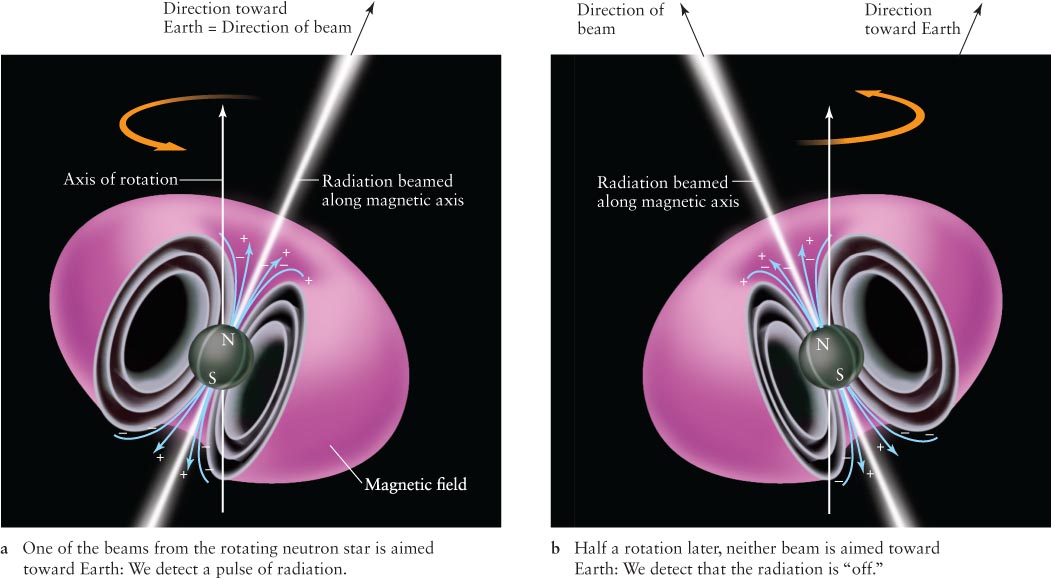
365
This explanation for pulsars is often called the lighthouse model. A rotating, magnetized neutron star is somewhat like a lighthouse beacon. The magnetic field causes nearby gases to accelerate and radiate. Depending on the conditions, this radiation can range from radio waves to gamma rays, and many pulsars emit in more than one spectral range. Calculations indicate that this radiation is beamed and, as the star rotates, it sweeps around the sky. If Earth happens to be located in the right direction, a brief flash can be observed each time a beam whips past our line of sight. As a result of its neutron star’s rotation, the Crab Nebula flashes on and off 30 times each second (see Figure 12-
The Crab pulsar is one of the youngest known pulsars, its creation having been observed some 960 years ago. Also visibly flashing is the Vela pulsar at the core of the Gum Nebula (see Figure 12-
Rotating neutron stars create other phenomena besides normal pulsarsPulsars typically have magnetic fields about 1012 times stronger than the magnetic field at the surface of Earth. Exceptional circumstances can conspire to raise the field strength a thousand times higher in some pulsars. If the neutron star is very hot (around 1011 K) and spinning very fast (100 times a second) when it forms, convection occurs throughout the neutron star, just as it does for red dwarfs (see Section 11-
Focus Question 12-9
If the lighthouse model of pulsars is correct, do we see all nearby pulsars? Why or why not?
366
Focus Question 12-10
How do the rotation rates of pulsars change with time?
The magnetic fields of a magnetar are so strong that they cause the neutron star’s surface to buckle and emit stupendous bursts of X-
In 2006, radio astronomers discovered yet another type of emission from rotating neutron stars. Called rotating radio transients, or RRATs, these objects give off bursts of radio and other emissions that last a few thousandths of a second, turn off for minutes or hours, and then spring briefly back to life. The neutron stars involved rotate slowly compared to most pulsars, spinning once every 0.4 to about 10 seconds. The most promising explanation, at present, is that these are older pulsars or magnetars that have slowed down.
12-8 Neutron stars have internal structure
Neutron stars are not composed solely of neutrons. Astronomers have developed a theoretical model for the surface and internal structure of neutron stars (Figure 12- km thick. The gravitational force of the neutron star is so great at its surface that climbing a bump there just 1 mm high would take more energy than it takes to climb Mount Everest.
km thick. The gravitational force of the neutron star is so great at its surface that climbing a bump there just 1 mm high would take more energy than it takes to climb Mount Everest.
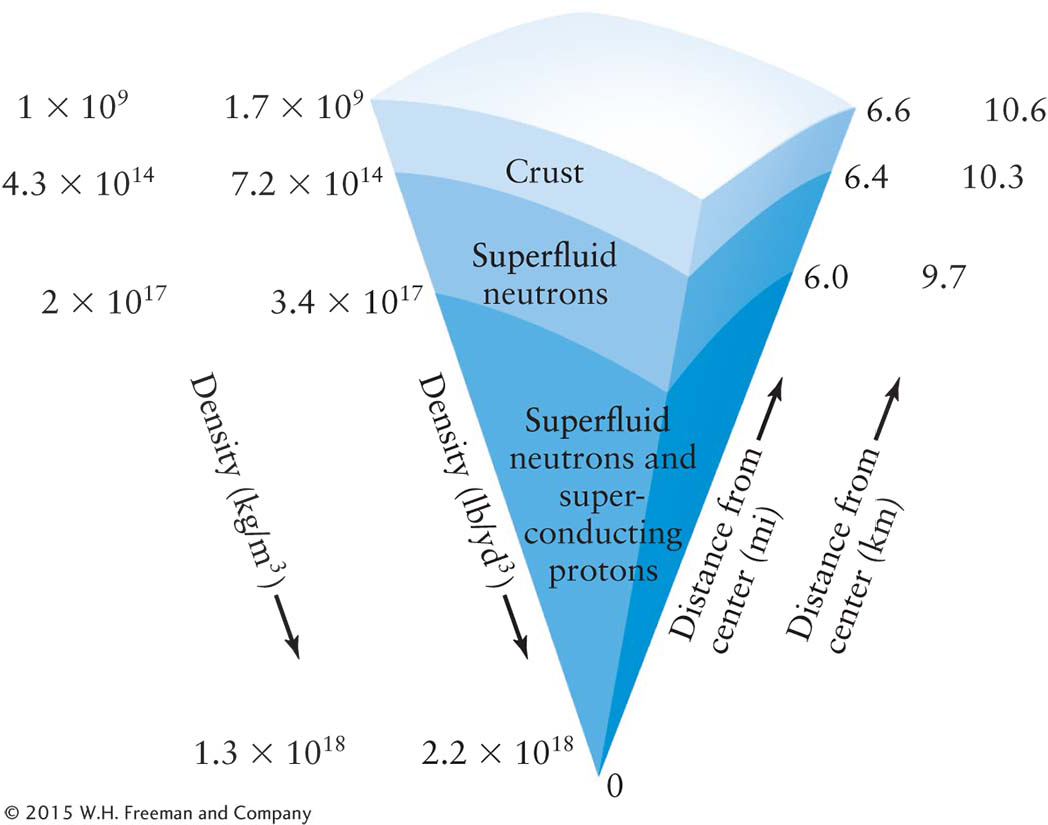
Neutron stars also have atmospheres a fraction of a meter (or of a yard) thick, as indicated by absorption lines in the spectrum of at least one of them. The absorption lines are believed to be due to scattering of radiation from the neutron star by gases in its atmosphere, just as scattering in the Sun’s atmosphere causes absorption lines in its spectrum.
In 2005, astronomers found indications that some isolated neutron stars expel energy long after they form. In particular, the Cassiopeia A remnant has regions glowing from radiation deposited on them as recently as 50 years ago (some 275 years after the supernova itself). The cause of this activity is still under investigation.
As noted above, an isolated pulsar radiates energy, which causes it to slow down. This “spin down” is not always smooth. As it slows down, it becomes more spherical, and so its spinning, solid surface must readjust its shape. Because the surface is brittle, this readjustment is often sudden, like the cracking of glass, which causes the angular momentum of the pulsar to suddenly jump. Just as Earth’s crust has earthquakes, calculations show that the crusts of rotating neutron stars have equivalent events. When a rotating neutron star (pulsar) undergoes such a quake, its rotation rate suddenly changes to conserve its angular momentum. This change creates a glitch in the rate at which the pulsar is slowing down. Such events have been observed in a number of pulsars (Figure 12-
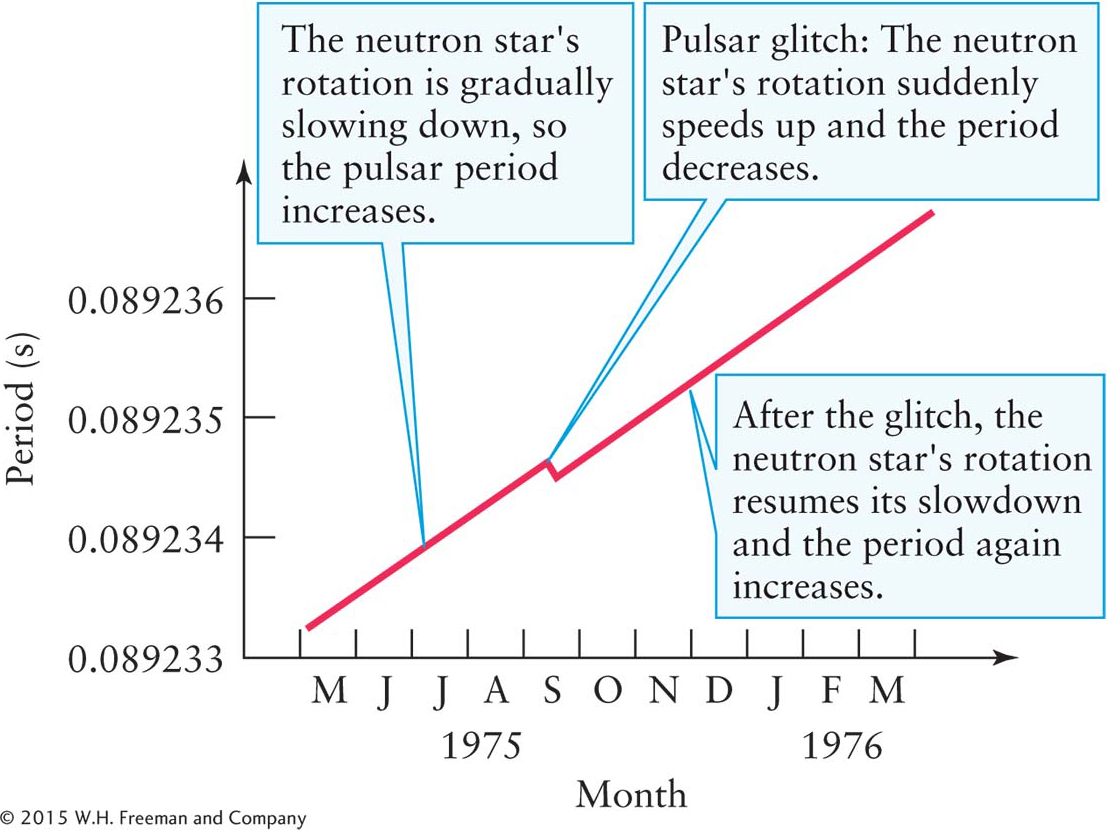
367
Some pulsars are in binary and three-
In 2004, astronomers observed, for the first time, a pair of pulsars in orbit around each other (Figure 12-
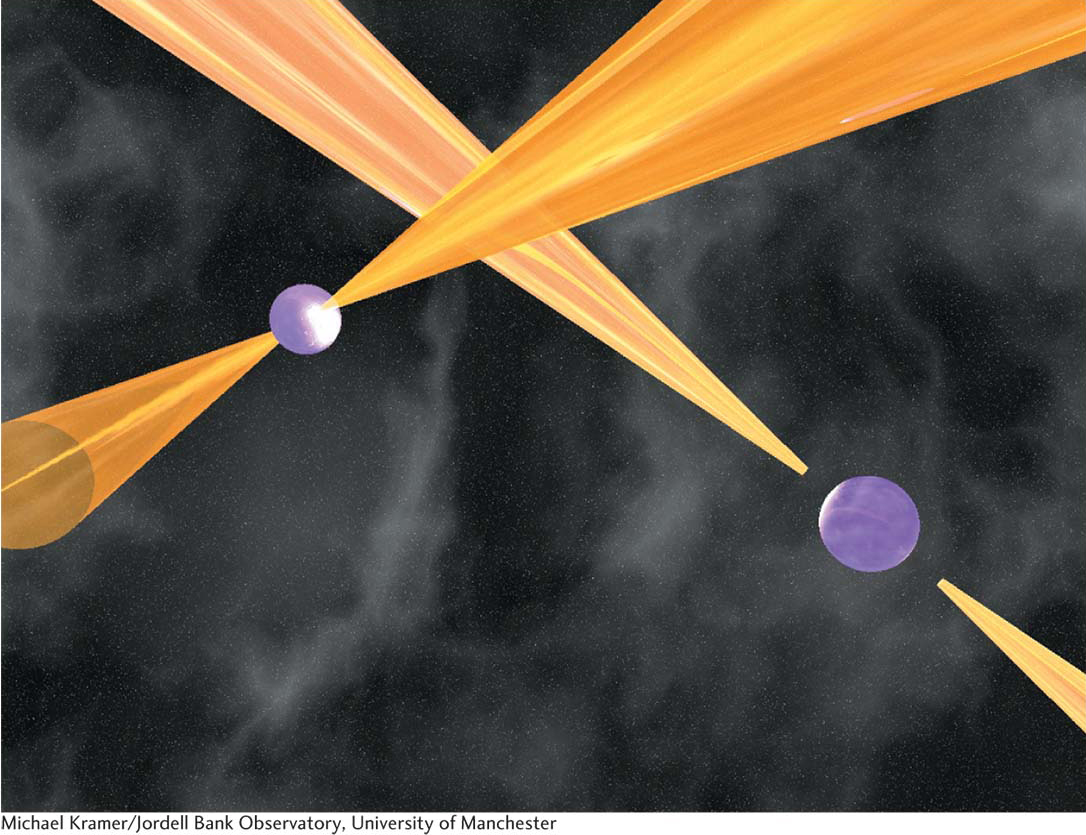
Focus Question 12-11
Why do glitches change the rotation rates of pulsars?
In 2014, astronomers observed a millisecond pulsar, PSRJ0337+1715, orbiting with two white dwarfs. This system is located in the constellation of Taurus. By studying it, astronomers are learning more about the gravitational interactions between closely orbiting stars and the effects of general relativity on such systems, among other things. Stay tuned!
12-9 Colliding neutron stars may provide some of the heavy elements in the universe
In the first few sections of this chapter we discussed nucleosynthesis, the process of creating the heavier elements. We saw how a variety of elements up to iron are created inside massive stars before the supernova occurs and are then ejected into space during the explosion. We also saw that even heavier elements are created and ejected during the supernovae themselves. However, models indicate that supernovae do not create enough of the elements heavier than iron to account for the amounts of these elements found in the universe.
Computer simulations of what happens during collisions of two neutron stars predict that, in these impacts, some of the neutrons are splashed into space, where many of them decay back into protons, fuse together, and help form various elements. The interactions that follow create a variety of heavy elements in amounts consistent with observations. For example, formation of an isotope of the element thulium requires neutron densities only available in neutron stars.
12-10 Binary neutron stars create pulsating X-ray sources
Neutron stars in binary systems may also hold the key to another regular pulse from the sky—
Astronomers were so intrigued by these preliminary discoveries that NASA built and launched Explorer 42, an X-
Uhuru gave us our first comprehensive look at the X-
368
The discovery of pulsars was still fresh in everyone’s mind when the Uhuru team discovered X-
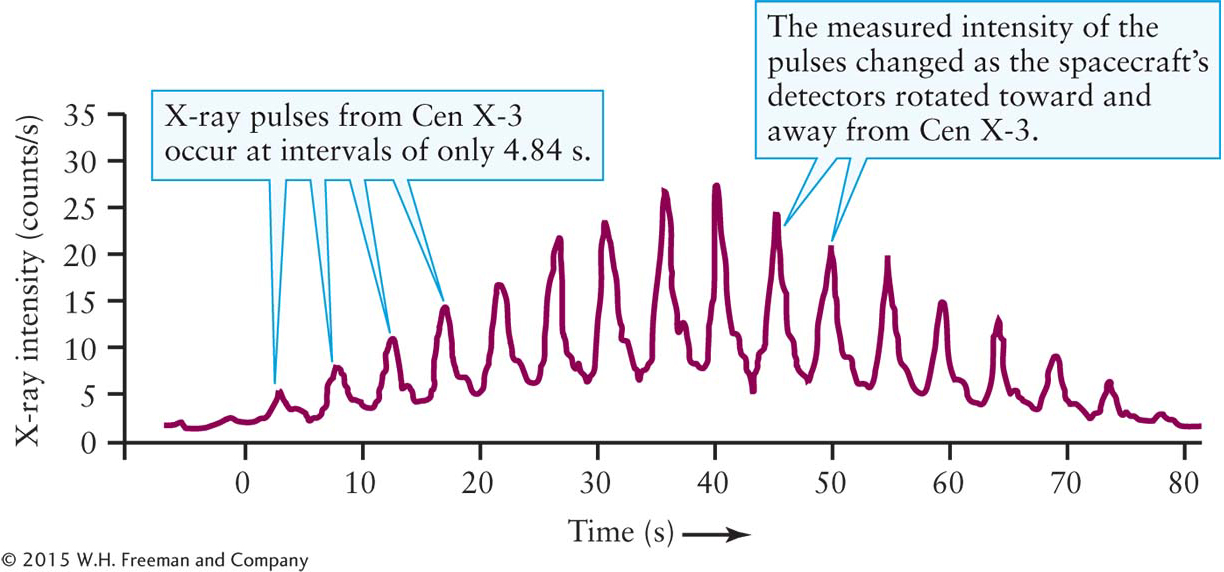
It soon became clear, however, that systems such as Centaurus X-
The case for the binary nature of Hercules X-
Astronomers now realize that systems such as Centaurus X-
To explain the pulsations of X-
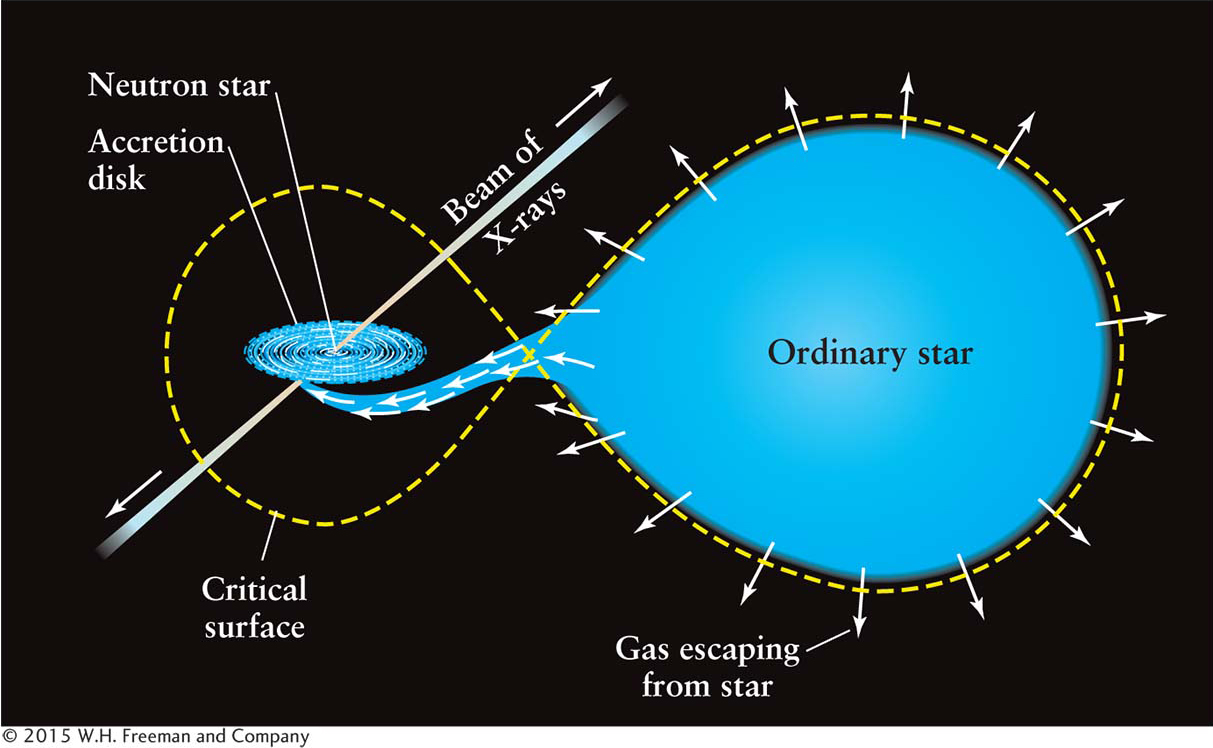
The neutron star in a pulsating X-
369
Neutron stars in binary systems can also emit powerful isolated bursts of X-
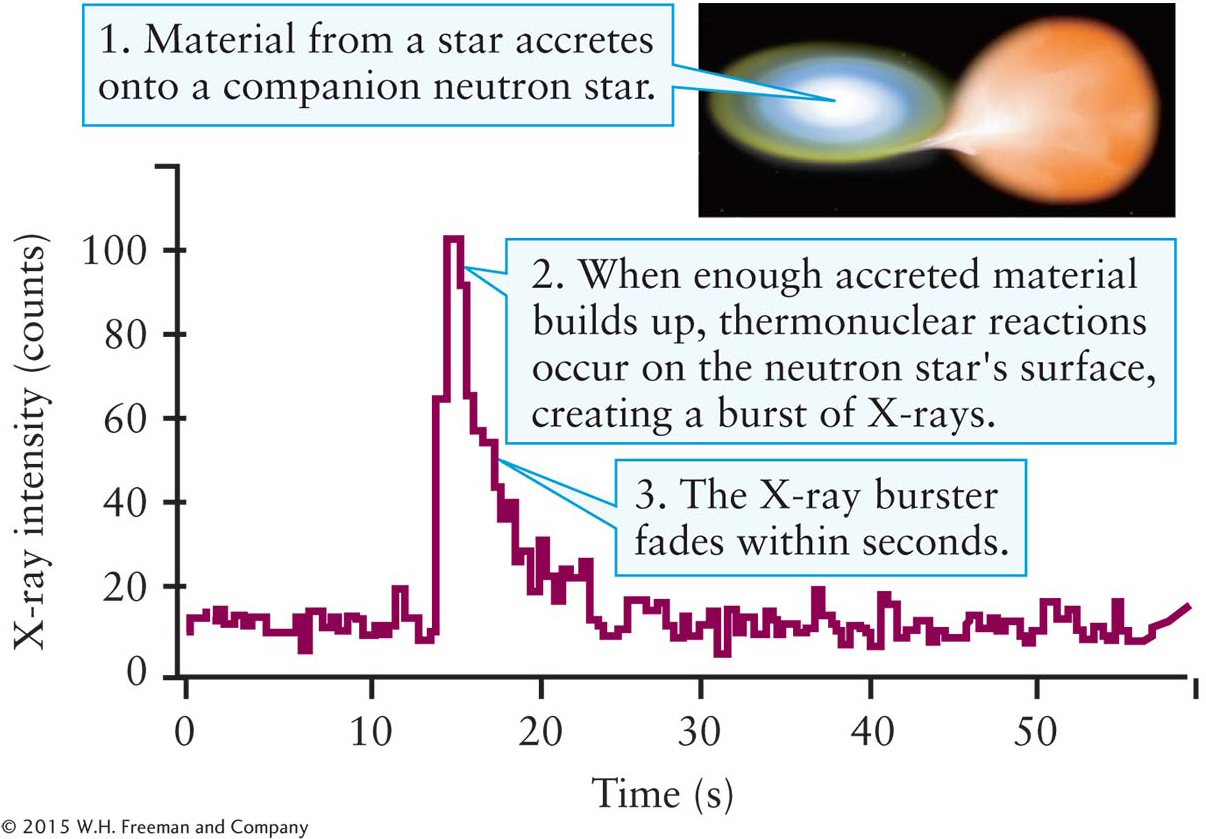
X-
Most of the gas falling onto the neutron star is hydrogen, which becomes compressed against the hot surface of the star by the star’s powerful surface gravity. In fact, temperatures and pressures in this accreting layer are so high that the arriving hydrogen is promptly converted by fusion into helium. Constant hydrogen fusion soon produces a layer of helium that covers the entire neutron star. When the helium layer is about 1 m (1 yd) thick, helium fusion ignites explosively, and we observe a sudden burst of X-
Focus Question 12-12
Is an X-
Just as white dwarfs have a maximum mass, above which the electron degeneracy pressure preventing their collapse gives way, so too do neutron stars have a maximum stable mass. Beyond 3.0 M⊙ the force of gravity overwhelms neutron degeneracy pressure and the neutron star implodes. The consequence of that event, a black hole, is what we turn to next. To understand the bizarre properties of black holes, we first must take a short excursion into the realm of Einstein’s theories of relativity. Most of the concepts presented here fly in the face of our intuition. Consider, for example, a car ride.